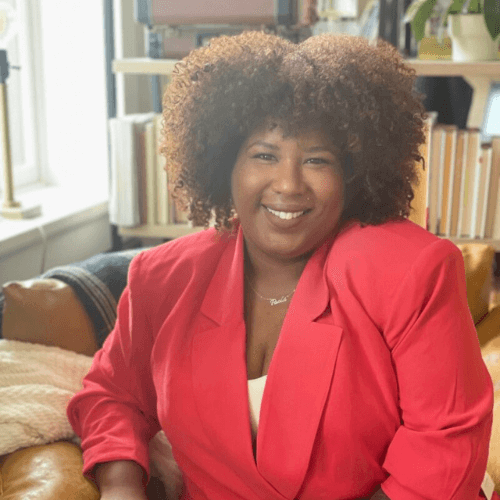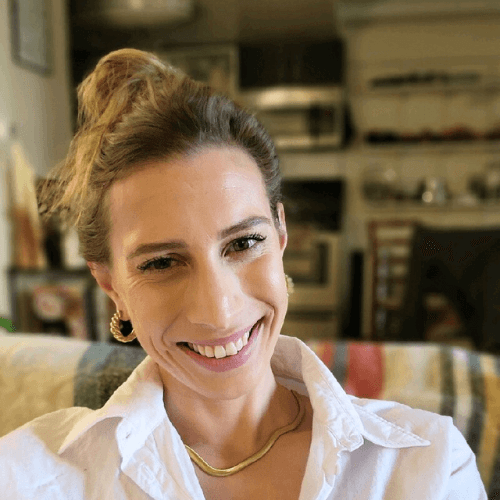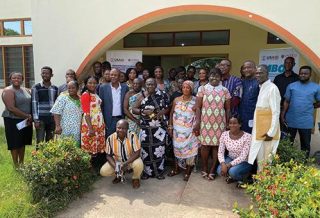FOCUS
6 principles to foster voice and belonging: ONLINE EXCLUSIVE
By Paola Deliz Félix Encarnación, Mary Halling, Andrea Carter and Stephanie Wu
Categories: Continuous improvement, Data, Improvement science/networksApril 2023
Amid soaring rates of teacher burnout and attrition, we at City Year are finding a trend that may seem surprising: Participants in our Network for School Improvement, when asked how likely they would be to recommend the network to other colleagues, have given an average rating of 9 out of 10. With many educators citing increasing responsibilities as one of the main reasons for exiting the job, wouldn’t taking on responsibility for yet another initiative make them feel even more overwhelmed?
We have found the opposite to be true, and we believe the following characteristics of our school improvement network are key: We trust that educators have theories of how to improve outcomes for students at their schools, respect their expertise and agency, and honor their humanity.
We prioritize these elements because they are good not only for educators, but also for students. When teachers and principals feel appreciated, empowered, and valued, they are more likely to cultivate those same experiences and feelings in their students.
What’s good for educators is good for students.Trust that educators have theories of how to improve outcomes for students at their schools, respect their expertise and agency, and honor their humanity. @CityYear #TheLearningPro Share on XAbout our network
Our network consists of schools that work in partnership with City Year and the Johns Hopkins University Everyone Graduates Center. Our aims are for schools to learn continuous improvement practices and be able to replicate and sustain them to shift outcomes and educational opportunities for 8th-grade Black and Latinx students and students who’ve experienced poverty.
In the 2021-22 school year, City Year and the Everyone Graduates Center engaged teams from 30 schools in Milwaukee, Wisconsin, Tulsa, Oklahoma, and Jacksonville, Florida, reaching over 110 educators, including 8th-grade teachers, principals, school social workers, students, parents, and other school support staff, depending on a school’s goals. These teams ultimately reach more than 6,000 students.
Each team begins by identifying a specific challenge to student success, focusing on the areas of attendance, behavior, and course performance, and then examines one or more root causes of the challenge. Next, the team selects a change idea and creates a plan to test that idea using change strategies curated by City Year and the Everyone Graduates Center.
The plan incorporates both academic and social-emotional development strategies and includes step-by-step directions to implement the change idea within the context of a school. These strategies assist teams in implementing and measuring success for each change idea, for example, through iterative plan-do-study-act (PDSA) cycles, typically lasting a few weeks. Ideally, teams go through several PDSA cycles in an academic year and may also have multiple change ideas that they want to test.
Throughout the year, teams meet biweekly to check progress of their change idea and review data. They also touch base monthly with their City Year network leader to share what they’ve learned and offer feedback. The entire network meets three to five times during the year to collaborate and exchange ideas.
In each of their change cycles and learning experiences, teams hone instructional practices and tools that can create valuable learning, ultimately encouraging holistic student development.
6 key principles
We have found that six key principles can foster voice and belonging for educators so that educators, in turn, replicate those practices in classrooms with students. Here we describe those principles and give examples of how we model them for educators and how educators have implemented them with students.
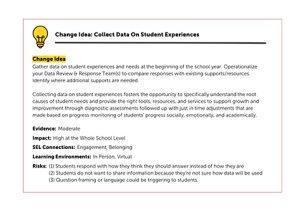
1) Co-authored content and programming: Ensure that everyone has a say in the overall design of learning experiences.
How we model the principle with educators
One of the ways we embody this principle is by gathering information and opinions on what is top of mind for network schools and using that information to design our network learning experiences.
For example, when each City Year network leader meets with principals and educators, we use a standard digital form to ask educators key questions, such as: “What questions do we need to be answering together?” and “What are tools you are using that we should share with the whole network?”
Through this, our school partners elevate interest in specific topics and provide feedback on where and how they need additional professional learning. When we use that information to inform and plan the learning experiences, participants facilitate and serve as content experts as well as consultants and content creators of the information that others get to experience later.
Change ideas for schools
One strategy for engaging in co-authored programming is collecting data on student experiences. This approach can help educators understand the root causes of students’ needs and adjust their instruction and supports accordingly. The figure above, “Change idea: Collect data on student experiences” shows how we present this idea to network teams.
Teams using this change idea develop a list of need-to-know topics related to student needs and experiences, establish a data collection calendar and process, and, following the collection of data, host a meeting with the full data review and response team to examine the results and establish what the most important findings are.
Teams work with the data review and response team or a broader group of stakeholders to identify where the school has existing supports for the categories of needs identified. Together, they compare the identified student needs from the results of the data review with the available resources and capacity identified in the resource map. As a team, they identify the highest-priority areas to add additional supports and resources to support student needs (Balfanz, 2021).
2) Space for powerful reflection: Make way for self-reflection on identity, lived experiences, school context, and current events.
How we model the principle with educators
It is critical to create environments and experiences that are rooted in and advance equity for the people we serve and work with. Therefore, we are intentional and explicit about creating opportunities for network educators to reflect on the identities we bring to this work.
One tool our team created begins with reflection and inner work before moving through many other steps of decision-making, acknowledging that we first must do the work of understanding where we’re coming from and what that means for how we will think about the work we engage in.
Regarding our identity, we ask ourselves: “How does my identity connect or not connect to the goal, students, staff, school, and the community?” as well as “What do I value?,” “How do I feel?,” and “What are my biases or blind spots?” about the goal and the people involved. This conversation allows all to consider how we show up and what happens because of that.
Change ideas for schools
We recommend schools root their work in identity with an intentional approach to welcoming students into the school and creating a shared narrative as a community. In the approach we suggest, educators prioritize creating space in onboarding for students and teachers to share their feelings, concerns, and hopes for the future of the school.
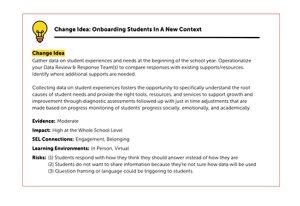
Together, teams create a shared narrative about how, as a school community, they need to act and operate to get through the changing contexts. With a shared narrative, teams work together to identify practical ways to achieve what they identified.
Teams might implement class meeting spaces where students discuss their experiences with trauma, racism, world and local events, or other topics and develop ways to support each other. Or they might continue new ways of using technology, such as recording lessons for students who are absent or need additional time with the content, allowing communications with teachers over email and online chat, or holding virtual meetings with parents instead of requiring them to show up in person (Balfanz, 2021). See the figure above,“Change idea: Onboarding students in a new context.”
3) Timely and relevant information: Work with information that’s helpful in today’s context.
How we model the principle with educators
Over the last two years, teachers in our network have repeatedly elevated voice and belonging as central to positive developmental environments, even above other things like meaning making, reflection, and active engagement. In response to this, City Year and the Everyone Graduates Center created a group of strategies specifically designed to assist schools in developing the social and emotional supports to complement these plans. We see this as essential for students to stand on and meet success (Balfanz, 2021).
Change ideas for schools
A Milwaukee team wanted to test a change idea centered on improving the culture and climate of the 8th grade. The team organized a group of students to meet weekly in the library for an hour at the end of the day to discuss how they might decrease 8th-grade suspensions. Teachers nominated students, who were then invited to join. Each meeting, the group looked at disaggregated suspension and referral data from the previous week, identifying trends, sharing additional data, proposing solutions, or asking more questions to determine next steps.
Because they were working with timely data, students and adults could have conversations right away about how they might improve this situation. They discussed what they liked about other classroom environments, what their role might be in creating a better environment in the classroom, and ultimately, teacher coaches who were in the meetings with students could approach the solution from a different angle.
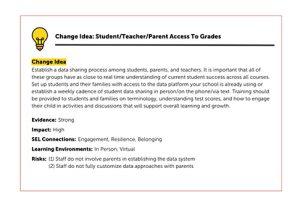
4) Quick feedback loops: Create opportunities to implement feedback.
How we model the principle with educators
A cornerstone of improvement science is using short-cycle data to make small but meaningful improvements. These rapid iterations allow teams to decide quickly whether what they’re doing is leading to an improvement and to consider whether they should adopt the change at scale as is, adapt it based on what they’ve learned and continue to test it, or abandon it and try something else.
At our first in-person network-wide annual learning convening in May 2022, we offered three-question surveys at the end of each day. The events team reviewed the responses each evening to get a quick check of how attendees were experiencing the event, what they were enjoying, and what they thought the gaps were.
Because of this, our team was able to make a small change that had a large impact: working with technicians at the event location to adjust the temperature in one of the breakout spaces. Several attendees noted that it was extremely cold and thus unusable; it ended up costing them precious breakout session time that first day because they had to find another space. It was fixed by the next morning, and attendees let us know how grateful they were for the adjustment.
Change ideas for schools
When teachers, students, and their families come together to determine how to provide access to timely and relevant course performance data for all courses, everyone can see how learning is progressing, and this can inform next actions. The figure above, “Change idea: Student/teacher/parent access to grades” shows one way to do this.
Involving parents and students from the beginning is key. We suggest piloting prototypes with parent focus groups for feedback to improve design of data systems, tutorials, and communications.
Additionally, teams can find out what kind of feedback parents would like to see in progress notes or schoolwide data reports and ask if the information is presented in a way that is easy to understand. Educators can regularly survey parents, students, and other teachers to see how often they access the system, what information is useful, and why or how it is useful.
5) Foster belonging through surprise and delight: Contribute to a sense of belonging by making people feel known.
How we model the principle with educators
At our Milwaukee site, we sent out a start-of-year survey to capture some basic information about each educator in the network, ranging from how they learn best, to how comfortable they are with technology, to what they like to eat and drink. We used the results to customize participants’ experiences at the first learning session, which was scheduled to last for the better part of an entire day.
We provided not only the standard coffee and milk options, but peppermint mocha creamer for one educator, hazelnut sugar-free creamer for another, green tea, and so on. It was a simple gesture that showed we were really listening to them, not just asking them to fill out forms and surveys without any follow-up.
Change ideas for schools
A team in Tulsa wanted to improve the depth and breadth of student-adult relationships so students would feel their voices were heard and valued. They formed a planning committee of 8th graders to design an end-of-year celebration for the class. All 8th-grade students answered a survey that measured their relationships with adults at school, both before and after the end-of-year celebration.
On the pretest, 26.5% of students said they did not have a positive relationship with at least one adult in their school. That figure decreased to just 5.3% on the post-test. Of the students on the planning committee, 100% of them reported they have a positive relationship with at least one adult in their school, indicating that those involved in the student change team were more likely to feel connected to adults in the school building.
6) Direct lines of communication: Get the right people in the room.
How we model the principle with educators
Our site in Jacksonville, Florida, hosted a start-of-year kickoff convening with principals. Several key people from the school district also attended. Principals met with the district attendees in a learning environment designed for adults to grapple with struggles they and their students were facing. For example, the principal of Southside Middle School voiced concerns about language barriers and supports needed for English learners, who make up 40% of the 8th-grade student body.
Change ideas for schools
One of our schools, in Milwaukee, targeted low 8th-grade student attendance by creating two new student clubs: student council and the gay-straight alliance. The clubs met weekly and monthly, respectively, and attendees were given pre- and post-tests to rate their perception of school rules, physical spaces, the school’s energy, and overall student behavior.
Students in both groups were able to access adults in the building and, because of that direct line, were able to learn new skills and socialize with peers in safe and engaging ways. And it appeared to help with their attendance as well: On meeting days, students’ average attendance was 92.86%, compared to the overall school average of 75.3%.
THE POWER OF NETWORKS
Convening teams of educators to solve complex problems together is an opportunity to experience and model the conditions of voice and belonging with one other. Educators can leverage the six principles presented here and implement them in ways that are appropriate to their contexts to make change. The results demonstrate the power of a network and collective knowledge and action.
Related resources
Connection Circles: How to Establish a Restorative Circle Practice: bit.ly/2E1dhoE
Road Map for SEL Re-Entry: bit.ly/3JAuWm8
Tips for Administrators, Teachers, and Families: How to Share Data Effectively: bit.ly/3z2WonJ
Five Lessons in Linking Families to Student Data Systems: bit.ly/3lFnJcI
Measuring What Matters: A Framework Review: bit.ly/40qmjSk
Resource Mapping Strategy: bit.ly/3JKHLdV
Data Driven Dialogue: bit.ly/3Zga0qm
Download a pdf here.
References
Balfanz, B. (2021, July 29). Behavior, resilience, and engaged learning change package. Johns Hopkins University Everyone Graduates Center.
Categories: Continuous improvement, Data, Improvement science/networks
Recent Issues
WHERE TECHNOLOGY CAN TAKE US
April 2024
Technology is both a topic and a tool for professional learning. This...
EVALUATING PROFESSIONAL LEARNING
February 2024
How do you know your professional learning is working? This issue digs...
TAKING THE NEXT STEP
December 2023
Professional learning can open up new roles and challenges and help...
REACHING ALL LEARNERS
October 2023
Both special education and general education teachers need support to help...


